Art History
Was Roy Lichtenstein an Appropriation Artist or Plagiarist? A New Documentary Probes the Ethics of His Multimillion-Dollar Comic Art Empire
The film features comic artists whose work has been source material for the Pop artist.

The film features comic artists whose work has been source material for the Pop artist.

Min Chen

In the 1960s, when Roy Lichtenstein began incorporating comic strips into his paintings, he framed the gesture as a form of ironic appropriation. His use of cartoons and comics was meant to recontextualize a form of mass media, if not to examine the bounds of high and low aesthetics. “The closer my work is to the original,” he explained in 1972, “the more threatening and critical the content.”
The comic artists and illustrators whose works have served as fodder for Lichtenstein’s canvases, however, have a different word for all of it: theft.
Since the 2000s, there has been a chorus of voices emerging from the comic book community decrying Lichtenstein’s lifting of comic art—a cribbing so liberal, they say, as to be more plagiarism than appropriation. Leading the charge has been David Barsalou, a comic book collector whose years-long research project, Deconstructing Roy Lichtenstein, has surfaced how the Pop artist’s paintings are nearly identical to his comic book sources.
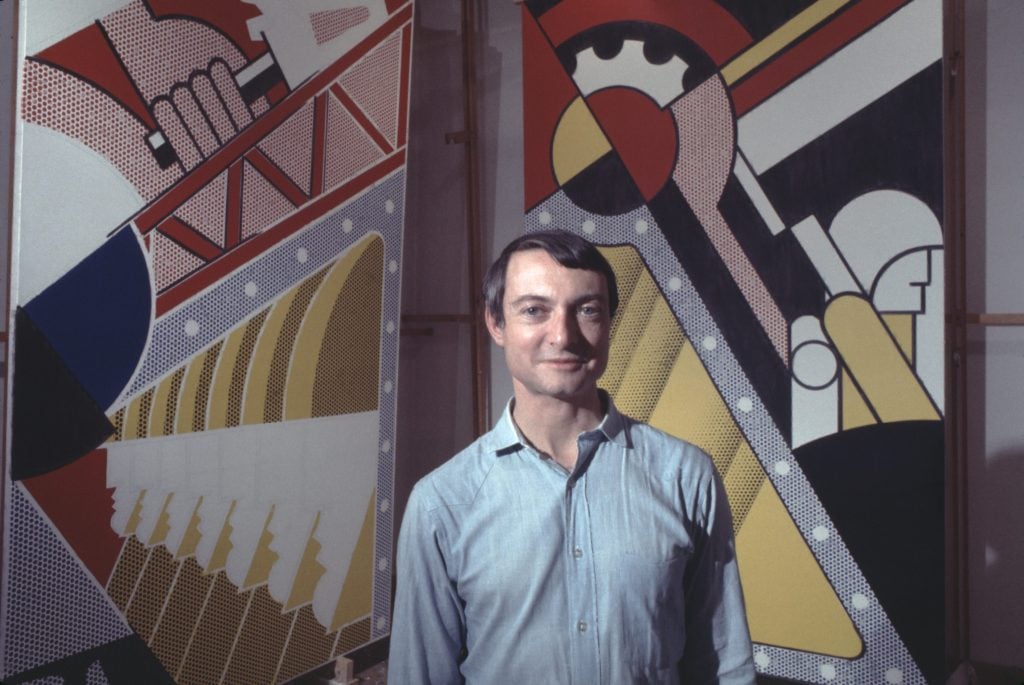
Roy Lichtenstein in his New York studio in 1968. Courtesy of Jack Mitchell/Getty Images.
“A lot of Lichtenstein’s stuff is so close to the original that it actually owes a huge debt to the work of the original artist,” Dave Gibbons, who drew 1987’s Watchmen, said in 2013. Art Spiegelman, creator of Maus, has been far more cutting, telling Publishers Weekly in 2007, “Lichtenstein did no more or less for comics than Andy Warhol did for soup.”
A new documentary, WHAAM! BLAM! Roy Lichtenstein and the Art of Appropriation, is the latest to weigh in. Coming from first-time director James Hussey, the film wades into the controversy through interviews with Lichtenstein experts, museum directors, and comic artists, in addition to visual comparisons of Lichtenstein’s canvases and the comic strips he “appropriated,” courtesy of Barsalou.
“I knew that Lichtenstein was an appropriative artist, but after reviewing Barsalou’s research, I was surprised about how closely many of Lichtenstein’s paintings followed the original sources. And I don’t believe I’m alone,” Hussey told Artnet News. “From my interactions, I’m convinced that many, if not most, fans of his work believe he is simply appropriating the comic style, not an actual image produced by another artist.”
WHAAM! BLAM!, Hussey emphasized, isn’t meant as an exposé to “cancel” Lichtenstein, but rather, to “stimulate debate” as it tackles the ethical, legal, and very human implications of artistic appropriation. The film recognizes appropriation as an essential gesture in art, giving due credit to Lichtenstein’s conceptual intent and his Pop legacy.
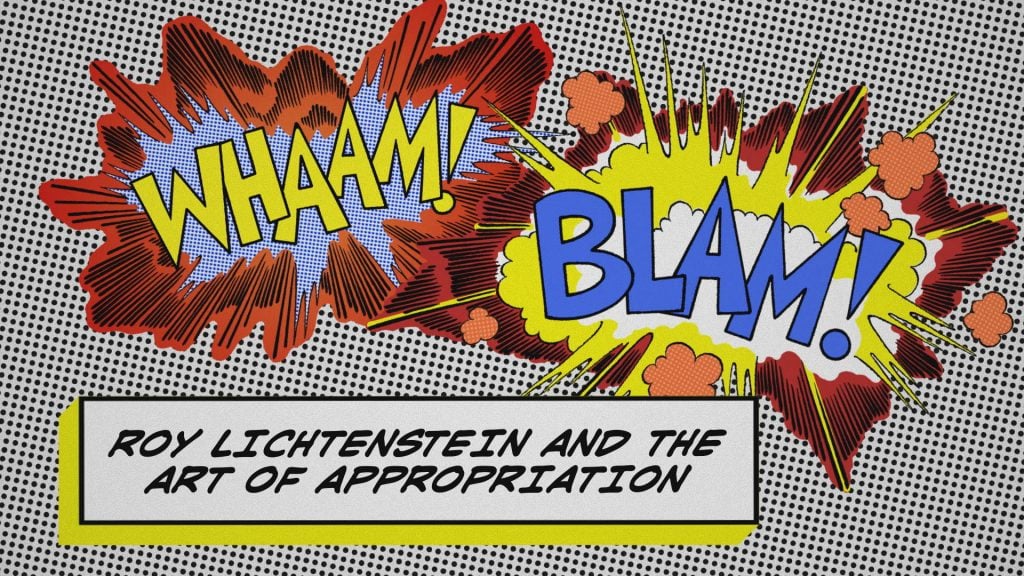
Title card for WHAAM! BLAM! Roy Lichtenstein and the Art of Appropriation. Photo: Hussey-Cotton Films Ltd.
But as it rolls along, so appears the chasm that divides so-called “high art” and “low art,” which has facilitated this appropriation. One art historian, Nathan Dunne, who authored the 2012 book Lichtenstein, even said the quiet part out loud, endorsing the Pop artist’s swiping of comic art since it was created by mere “draftsmen.”
“It seems to me that their dialogue is chiefly with one another within their community,” Hussey reflected of his conversations with fine art experts, “with little concern about how their comments may be viewed by an outsider, who may consider their language to be elitist. I also believe that this ‘inside’ talk often prevents those within the fine arts from seeing or considering significant issues, such as the role that the original ‘low art’ artists played in Lichtenstein’s work.”
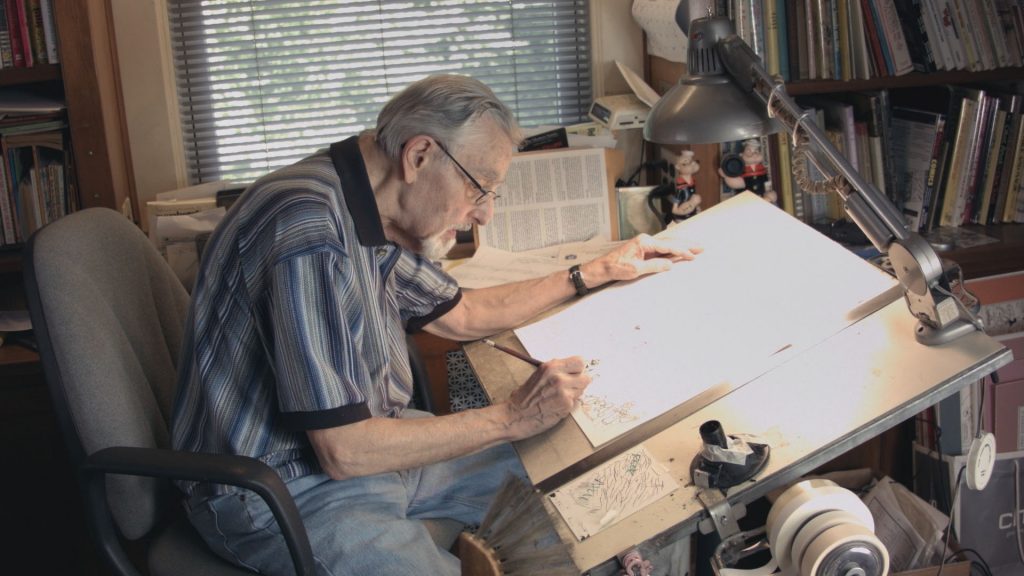
Hy Eisman at his drafting table in WHAAM! BLAM!. Photo: Hussey-Cotton Films Ltd.
These “draftsmen,” too, take issue. The film spotlights two comic artists, Russ Heath and Hy Eisman, who reflect on the effect of Lichtenstein’s “theft” with some understandable resentment (according to Hussey, another artist, John Romita, turned the film down because “he was too bitter to rehash the issue”).
Heath, in particular, was no plain drafter. He made his detailed and dynamic scenes for DC’s beloved 1960s military series, such as G.I. Combat and Sea Devils, by referencing props and live models. For him, it was never “just comics,” as he told the Comics Journal in 2018. “I always tried to improve my technique,” he said. “It cost me a lot of money because that attitude slowed me down, but that’s my temperament.”
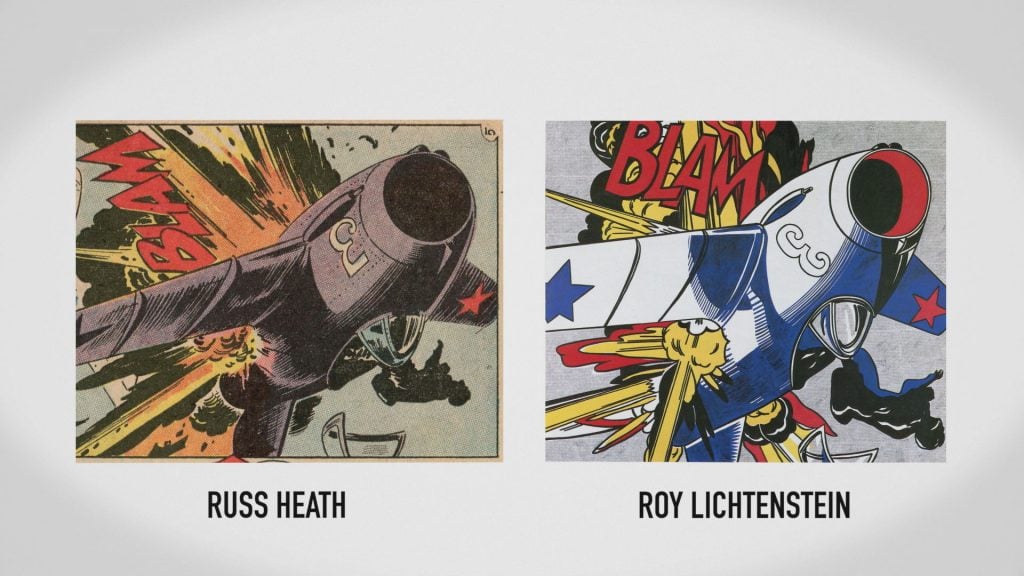
Still from WHAAM! BLAM! comparing a panel from All-American Men of War #89, drawn by Russ Heath, and Roy Lichtenstein’s Blam (1962). Photo: Hussey-Cotton Films Ltd.
But Heath’s work, while celebrated in comic book circles (he was inducted into the Will Eisner Award Hall of Fame in 2009), has remained unacknowledged by the fine art world. While Lichtenstein’s Blam (1962), which was lifted from one of Heath’s panels in All-American Men of War #89, has pulled in millions at auction, the comic artist struggled financially. His final days, as captured in the documentary, were spent in a dingy one-bedroom apartment, and relying on charity for his groceries and a knee surgery. Blam, meanwhile, hangs in the Yale University Art Gallery.
“As one commentator noted, if Heath and Eisman had received acknowledgment for their role in Lichtenstein’s work back in the 1960s, their careers and earning potential may have profited,” said Hussey.
All of which begs the question: Why doesn’t someone sue? As the film does explore, if any suits were to be filed, they should be coming from the comic book publishers (and they aren’t), not the artists themselves. And if anything, it’s been the Lichtenstein estate that has sent rather salty cease-and-desist letters to Barsalou in an attempt to halt his online project.
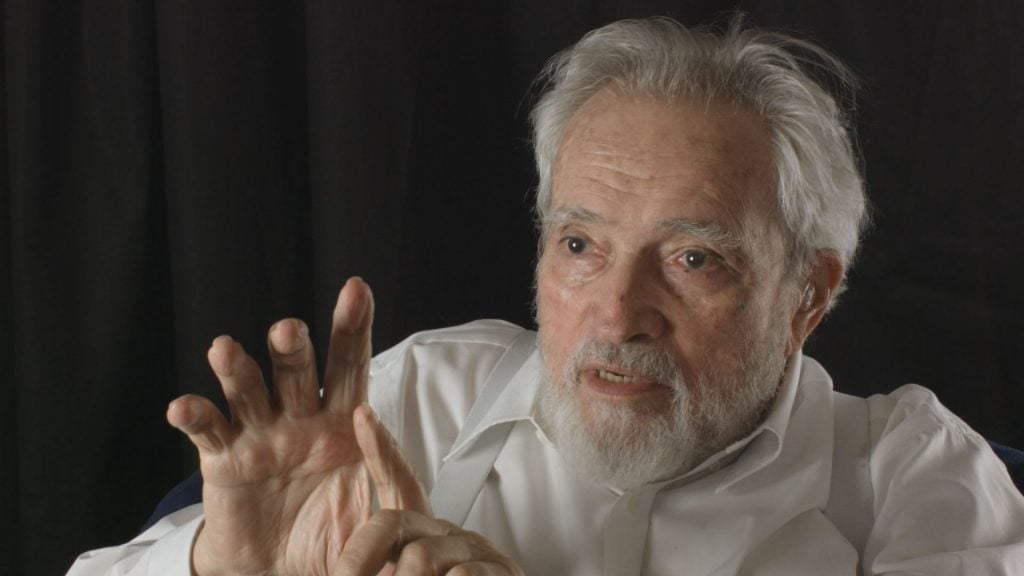
Russ Heath in a filmed interview for WHAAM! BLAM!. Photo: Hussey-Cotton Films Ltd.
WHAAM! BLAM!, just as it fills in the gaps in our understanding of Lichtenstein’s creative process, more vitally underscores these asymmetrical power dynamics involved in his appropriation. The film, then, is as much a restorative effort: If Lichtenstein’s adaptation of comic art was indeed meant to “elevate” the form to the level of fine art, as is Pop custom, then the medium should, well, be elevated.
“I hope these [comic] artists will receive proper acknowledgement by the galleries which display Lichtenstein’s work, and by the scholars who write about this renowned Pop artist. Their contribution is an essential part of Lichtenstein’s story,” said Hussey. “Russ Heath, Hy Eisman, and the many other comic artists whose work was appropriated by Lichtenstein also deserve their day in the sun.”
WHAAM! BLAM! Roy Lichtenstein and the Art of Appropriation begins streaming on demand on Amazon Prime, Apple TV, Vimeo, and Vudu from March 21.